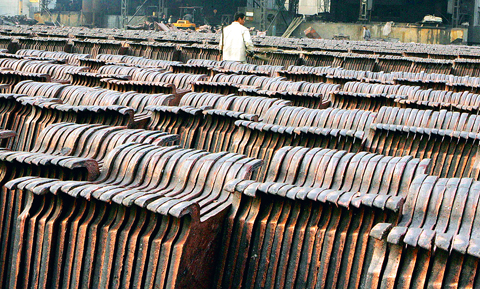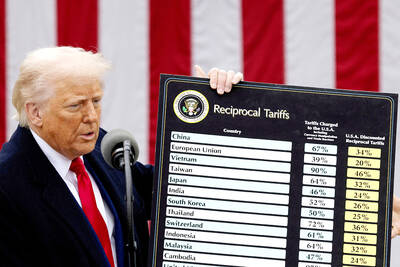When China hits the brakes, commodities exporters half a world away have to shift to a lower gear, as the rapidly deteriorating fortunes of the copper sector shows.
The global financial crisis has impacted China’s copper-wired construction industry, machine makers and electric appliance producers at an amazing speed, with demand at home and abroad crumbling abruptly.
Just as precipitously, China, the world’s largest consumer of copper, has passed on the misery to countries like Chile, its largest copper supplier.

PHOTO: AFP
Chile’s mines have cut production and laid off workers, leading to violent strikes in some parts of the country.
“Business has fallen off a cliff,” Simon Hunt, an independent UK-based analyst, said after recent visits to Chinese and other Asian copper firms.
About 30 percent of China’s copper consumption goes into exports, Hunt said.
“The impact of these [global] developments on China’s economy and its copper consumption will be dynamic,” he said.
World copper prices have more than halved to less than US$1.50 a pound (453g) after record highs of US$4 in July, as China’s once-ravenous hunger for commodities has slowed and weakening demand abroad has hurt exporters.
“As late as July, clients were calling, looking for assurance that China’s copper demand would maintain strong growth,” said Shi Lin, an analyst with British metal consultancy CRU. “Now everyone sees what happened.”
“Growth in China’s copper consumption accounted for 80 percent of the world’s overall growth. It’s no surprise copper prices were impacted so much by weakening Chinese demand,” he said.
China’s economic growth slowed to 9 percent in the third quarter, the lowest level in five years, and the World Bank has predicted it will go down to 7.5 percent next year — a 19-year low.
Copper has been a key raw material in China’s economic boom, and it consumes a quarter of the world’s supply, importing about 80 percent of its needs. Chile provides a third of China’s total demand.
The drop in Chinese demand has led to copper projects in the South American country, such as Canada-based Quadra Mining’s Sierra Gorda project, being shelved.
Commodities such as zinc, nickel, iron ore, and aluminum, too, have seen their prices plummet.
Anglo-Australian miner Rio Tinto said last month it slashed iron ore output at its Western Australia plants by 10 percent following a drop in demand from China. The company said on Wednesday it would cut thousands of jobs globally.
The world’s largest iron ore producer, Brazil’s Vale — whose principal market is China — also slashed production.
Next year’s contract iron ore prices are expected to decline 35 percent as China’s steel sector suffers an industry-wide loss following a fall in steel prices, according to China International Capital Corp (中國國際金融公司).
Economists suggested demand for raw materials in China was not only dented by slowing industrial production, but expectations of prices falling even further, suggesting the worst may be yet to come.
For example, copper will likely follow the economy. Australia’s Macquarie Bank expects Chinese demand to slow to between 6 and 7 percent growth, at 5.1 million tonnes for this year, compared to nearly 18 percent in last year.
It could fall to between 4 percent and 5 percent next year, said Bonnie Liu (劉博雅), a Shanghai-based analyst with Macquarie.
Experts argue that Beijing’s US$586 billion economic stimulus plan was unlikely to boost copper prices anytime soon.
“China’s infrastructure spending spree by itself will not be enough to turn around the decline in major global commodity prices,” Frank Gong (龔方雄), a Hong Kong-based economist with JP Morgan Chase said in a note.
About a fifth of China’s copper demand goes into construction, and the property market has also stalled, with prices rising only 0.2 percent on the year last month — the slowest since monthly statistics began in 2005.

Rainfall is expected to become more widespread and persistent across central and southern Taiwan over the next few days, with the effects of the weather patterns becoming most prominent between last night and tomorrow, the Central Weather Administration (CWA) said yesterday. Independent meteorologist Daniel Wu (吳德榮) said that based on the latest forecast models of the combination of a low-pressure system and southwesterly winds, rainfall and flooding are expected to continue in central and southern Taiwan from today to Sunday. The CWA also warned of flash floods, thunder and lightning, and strong gusts in these areas, as well as landslides and fallen

WAITING GAME: The US has so far only offered a ‘best rate tariff,’ which officials assume is about 15 percent, the same as Japan, a person familiar with the matter said Taiwan and the US have completed “technical consultations” regarding tariffs and a finalized rate is expected to be released soon, Executive Yuan spokeswoman Michelle Lee (李慧芝) told a news conference yesterday, as a 90-day pause on US President Donald Trump’s “reciprocal” tariffs is set to expire today. The two countries have reached a “certain degree of consensus” on issues such as tariffs, nontariff trade barriers, trade facilitation, supply chain resilience and economic security, Lee said. They also discussed opportunities for cooperation, investment and procurement, she said. A joint statement is still being negotiated and would be released once the US government has made

SOUTH CHINA SEA? The Philippine president spoke of adding more classrooms and power plants, while skipping tensions with China over disputed areas Philippine President Ferdinand Marcos Jr yesterday blasted “useless and crumbling” flood control projects in a state of the nation address that focused on domestic issues after a months-long feud with his vice president. Addressing a joint session of congress after days of rain that left at least 31 dead, Marcos repeated his recent warning that the nation faced a climate change-driven “new normal,” while pledging to investigate publicly funded projects that had failed. “Let’s not pretend, the people know that these projects can breed corruption. Kickbacks ... for the boys,” he said, citing houses that were “swept away” by the floods. “Someone has

‘CRUDE’: The potential countermeasure is in response to South Africa renaming Taiwan’s representative offices and the insistence that it move out of Pretoria Taiwan is considering banning exports of semiconductors to South Africa after the latter unilaterally downgraded and changed the names of Taiwan’s two representative offices, the Ministry of Foreign Affairs (MOFA) said yesterday. On Monday last week, the South African Department of International Relations and Cooperation unilaterally released a statement saying that, as of April 1, the Taipei Liaison Offices in Pretoria and Cape Town had been renamed the “Taipei Commercial Office in Johannesburg” and the “Taipei Commercial Office in Cape Town.” Citing UN General Assembly Resolution 2758, it said that South Africa “recognizes the People’s Republic of China (PRC) as the sole